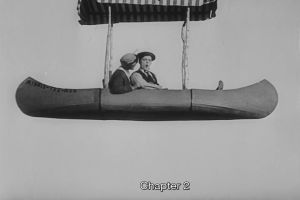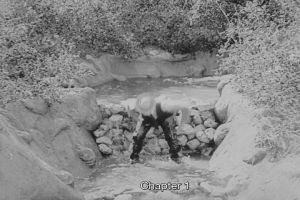The Balloonatic
The Balloonatic is a 1923 short comedy film by Buster Keaton. It was his final short for First National[1]. The film runtime is 27 minutes.
Plot
Buster Keaton goes to an amusement park where he sees a woman who interests him. He gets into a boat with her at the park and goes for a ride. He then finds a hot air balloon launch where he agrees to help the people putting it on my riding in the balloon and then unfurling a banner from the balloon once airborne. Once airborne he decides to shoot at ducks from the hot air balloon and in the process pops the balloon. Once he lands Buster finds himself in the wilderness. He once again sees the woman from the amusement park. With her in sight he attempts various methods of fishing such as using a rod and building a dam. Buster then has an intense interaction with two bears that is played for comedy.
Both Buster and the woman escape the bears and find themselves floating down the river in a boat. Unfortunately they reach a part of the river in which there is a waterfall. Unbeknownst to the audience until they go over the waterfall the boat has balloons affixed to it. Instead of tumbling over the waterfall Buster and the woman float away and the film ends.
Production
The river scenes were filmed on the Truckee River in California[1]. During production a fire burnt down the wood hotel that the actors were staying in forcing them to switch to less comfortable accommodations[1]. Unlike in many of his previous short films the woman (Phyllis Haver) drives much of the action instead of Keaton[1].
Cast
Buster Keaton as the main character
Phyllis Haver as the woman

